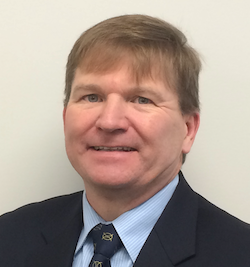Glenn Walters has a wealth of knowledge and experience in the marine industry. With over 35 years involvement in the sector (20 as a Canadian Naval Engineering Officer, 10 in industry and the last five as an independent consultant), Glenn is utilizing his experience in his current role as Global Membership Committee Chair, SNAME (Society of Naval Architects and Marine Engineers).

Growing up in the steel town of Hamilton, ON, he describes his entry into the marine sector as the truest definition of serendipity: a series of fortunate events.
“With the recession of 1982, the prospect of getting an education and a job had evaporated overnight,” said Walters. “My first and most life-changing moment was acceptance to the Royal Military College, followed by selection for the Navy.” His volunteering for submarines and then his selection for a Navy-sponsored marine engineering post-graduate studies along with an exchange position in the UK set the hook for “a career for life in the marine sector.”
Here is the full interview with Glenn Walters.
What is your role at your organization today?
In my SNAME volunteer role as the Global Membership Committee Chair, I work with the other volunteers across the globe with support from a lean headquarters staff to drive “value for membership” into the organization. With an aging demographic in our sector, SNAME’s primary focus over the last two decades has been on students and their transition into the marine sector as young professionals. We now support 44 SNAME student sections worldwide, with three in Canada (Memorial, UBC and IMQ).
What was your most challenging moment?
For those who have served at sea or below the sea, we all have had a bad day with a major system failure. I am glad to say that serendipity coupled with a well-trained and experienced team prevented that bad day from escalating to a really bad day. These experiences have equipped me with the resilience to keep moving forward, even when the odds (or others) seem against you.
What was your “aha” moment or epiphany that you think will resonate with most with our readers? Tell us that story.
We are all stronger when you take the time to get to truly know the people around you, for me, my active membership with SNAME is a great enabler. With the networking I have established with SNAME, I have assisted many people by offering short-term and long-term independent career mentoring. The “aha” moment comes when I have been successful in matching someone who is need of support or looking for a change of jobs with a company in need. We are all stronger together.
What is the one thing that has you most fired up today?
Full Speed Ahead: Firing on All Cylinders. After two decades of darkness commencing in the 1990s, we started to see the rebuild of the Canadian marine technical community in 2012. In the last seven years, we have rapidly grown, with many coming from outside traditional maritime backgrounds. Welcoming and assisting new people to the marine sector is a goal of SNAME. In addition to those who have Navy or Coast Guard backgrounds, we have had the privilege of technicians, technologist and engineers working hand-in-hand. I believe in Canada we have a need and opportunity to increase our productivity by more fully leveraging the skills and experience of technologists in our day-to-day work.
What is the best advice you received?
Roll up your sleeves and figure out the details. Often this necessitates reading and re-reading the technical specifications and guidance documents – I observe that more people should find the time to do this as a cost of doing business or as a long term investment in their own professional development. This is a key message I reinforce with SNAME young professionals (those in their first 10 years in the industry).
What is the habit that contributes to your success?
Collaboration. The recent MARITECH 2019 in Ottawa was conducted as a joint event between the Canadian Institute of Marine Engineers (CIMarE) and SNAME. This event, with over 600 participants and 75 exhibitors, enabled peer-to-peer and government/industry discussions at the technical practitioner level – a true demonstration of open and collegial discussion through two keynotes, three panels and 30 technical presentations. We also reached out to a number of organizations, such as the Chamber of Marine Commerce and government departments of DND, Coast Guard, Transport and PSPC. In addition, SNAME cooperates globally with other technical societies and organizations, such as Green Marine. As Karl Kenny, President Kraken Robotics, stated as the opening keynote at MARITECH, the true competition is often not your neighbour across the street.
What people or organizations do you believe best embody the innovation mindset?
The 2019 Elmer A. Sperry Award recipient, Sandy Thomson of Thordon Bearings best exemplifies the art of innovation. I had the privilege of presenting Sandy’s nomination for “advancing the art of transportation” to the Sperry Award board, comprised of six major technical societies (ASME, IEE, AIAA, SAE, ASCE and SNAME). For a sector that is perceived as being very conservative, Sandy demonstrated that the rule-based culture in the marine industry is always ready for innovation.
What is your parting advice?
Invest in yourself and your teams. Increasingly, the world is expecting you to continuously improve and exercise your skills to provide the necessary outcomes. Just like finance, advancing technical skills creates compound interest. Active participation in a technical society is a great enabler.
